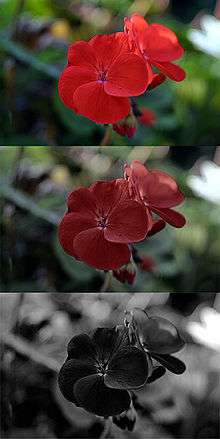Jan Evangelista Purkyně
| Jan Evangelista Purkyně | |
|---|---|
 Jan Evangelista Purkyne in 1856 | |
| Born |
December 17, 1787 Libochovice, Bohemia, Austrian Monarchy |
| Died |
July 28, 1869 (aged 81) Prague, Austria-Hungary |
| Citizenship | Austrian |
| Nationality | Czech |
| Fields | Anatomy, physiology |
| Institutions | University of Breslau |
| Alma mater | University of Prague |
| Known for | Purkinje cells |
Jan Evangelista Purkyně (Czech: [ˈjan ˈɛvaŋɡɛlɪsta ˈpurkɪɲɛ]; also written Johann Evangelist Purkinje) (17 December or 18 December 1787 – 28 July 1869) was a Czech anatomist and physiologist. He was one of the best known scientists of his time. In 1839, he coined the term 'protoplasm' for the fluid substance of a cell. His son was the painter Karel Purkyně. Such was his fame that when people from outside Europe wrote letters to him, all that they needed to put as the address was "Purkyně, Europe".[1]
He is buried in the Czech National Cemetery in Vyšehrad, Prague, modern-day Czech Republic.[2]
Biography
Purkyně was born in Bohemia (then part of the Austrian monarchy, now Czech Republic.) In 1818, he graduated from Charles University in Prague with a degree in medicine, where he was appointed a Professor of Physiology. He discovered the Purkinje effect, the human eye's much reduced sensitivity to dim red light compared to dim blue light. He published two volumes, Observations and Experiments Investigating the Physiology of Senses and New Subjective Reports about Vision, which contributed to the emergence of the science of experimental psychology. He created the world's first Department of Physiology at the University of Breslau in Prussia (now Wrocław, Poland) in 1839 and the world's first official physiology laboratory in 1842. Here he was a founder of the Literary-Slav Society.
He is best known for his 1837 discovery of Purkinje cells, large neurons with many branching dendrites found in the cerebellum. He is also known for his discovery in 1839 of Purkinje fibres, the fibrous tissue that conducts electrical impulses from the atrioventricular node to all parts of the ventricles of the heart. Other discoveries include Purkinje images, reflections of objects from structures of the eye, and the Purkinje shift, the change in the brightness of red and blue colours as light intensity decreases gradually at dusk. Purkyně also introduced the scientific terms plasma (for the component of blood left when the suspended cells have been removed) and protoplasm (the substance found inside cells.)
Purkyně was the first to use a microtome to make wafer thin slices of tissue for microscopic examination and was among the first to use an improved version of the compound microscope. He described the effects of camphor, opium, belladonna and turpentine on humans in 1829. He also experimented with nutmeg that same year, when he "washed down three ground nutmegs with a glass of wine and experienced headaches, nausea, euphoria, and hallucinations that lasted several days", which remain a good description of today's average nutmeg binge.[3] Purkyně discovered sweat glands in 1833 and published a thesis that recognised 9 principal configuration groups of fingerprints in 1823.[4][5] Purkyně was also the first to describe and illustrate in 1838 the intracytoplasmic pigment neuromelanin in the substantia nigra.[6]
Purkyně also recognised the importance of the work of Eadweard Muybridge. Purkyně constructed his own version of a stroboscope which he called forolyt.[7] He put nine photos of him shot from various sides to the disc and entertained his grandchildren by showing them how he, an old and famous professor, is turning around at great speed.[8]
Legacy
The Masaryk University in Brno, Czech Republic, bore his name from 1960 to 1990, as did the standalone military medical academy in Hradec Králové (1994–2004.) Today, a university in Ústí nad Labem bears his name: Jan Evangelista Purkyně University in Ústí nad Labem (Univerzita Jana Evangelisty Purkyně v Ústí nad Labem.)
The crater Purkyně on the Moon is named after him, as is the asteroid 3701 Purkyně.
References
- ↑ Bhattacharyya, KB. Eminent Neuroscientists: Their Lives and Works. Bimal Kuman Dhur of Academic Publishers, 2011, p.182
- ↑ Jan Evangelista Purkinje at Find a Grave
- ↑ Shafer, Jack (2010-12-14) Stupid drug story of the week: The nutmeg scare, Slate.com
- ↑ Jan Evangelista Purkyně, Commentatio de examine physiologico organi visus et systematis cutanei (Breslau, Prussia: University of Breslau Press, 1823)
- ↑ Harold Cummins and Rebecca Wright Kennedy (1940). "Purkinje's observations (1823) on finger prints and other skin features". The Journal of Criminal Law and Criminology 31 (3): 343–356. JSTOR 1137436.
- ↑ Usunoff, KG. Itzev, DE. Ovtscharoff, WA. Marani, E. Neuromelanin in the human brain: a review and atlas of pigmented cells in the substantia nigra. Archives of Physiology and Biochemestry, 2002, No. 4, p.257
- ↑ Sight and Sound British Film Institute, 1946
- ↑ Ludvík Souček, Jak se světlo naučilo kreslit (How the light learned to draw), SNDK, Prague, 1963, pp. 106–7.
External links
![]() Media related to Jan Evangelista Purkyně at Wikimedia Commons
Media related to Jan Evangelista Purkyně at Wikimedia Commons
- Jan Evangelista Purkyně at Monoskop.org
- Biography, "Purkyně (Purkinje), Jan Evangelista." @ Complete Dictionary of Scientific Biography. 2008. Encyclopedia.com biographical entry written by Vladislav Kruta
|
